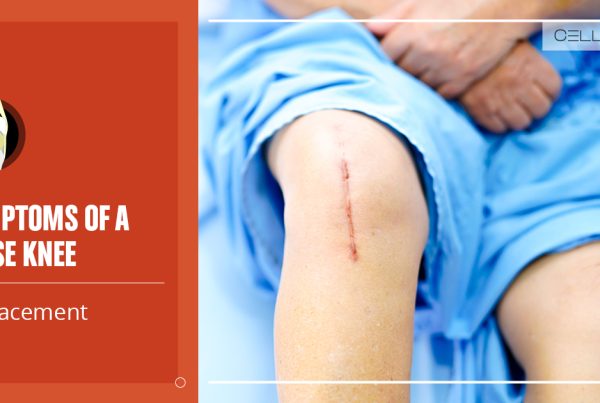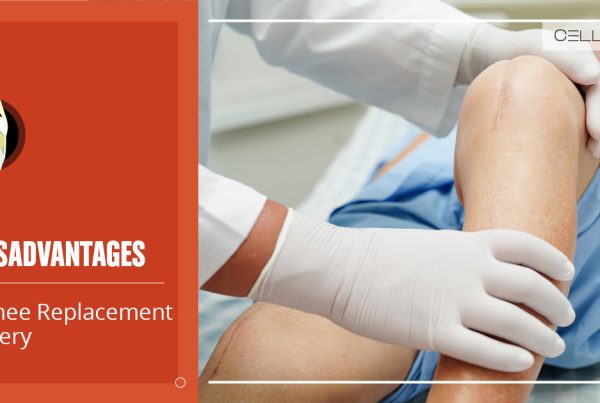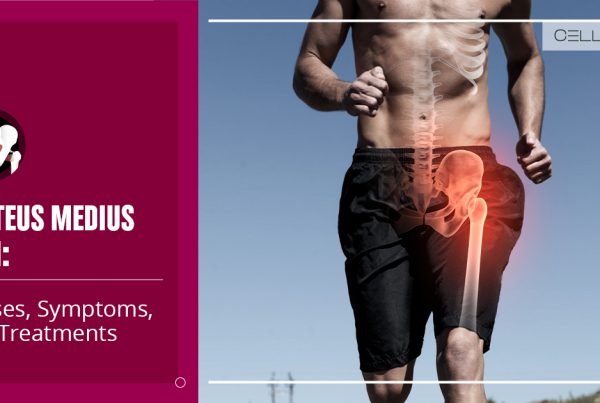Published on: October 7, 2019 | Updated on: November 5, 2024
Table of contents
- Intro
- The Knee Fat Pad
- Anatomy of Knee Fat Pad Impingement
- Causes of Knee Fat Pad Impingement
- Symptoms and Signs of Knee Fat Pad Impingement
- Diagnosing Knee Fat Pad Impingement
- Conventional Treatments for Knee Fat Pad Impingement
- Regenerative Therapy for Knee Fat Pad Impingement
- Prevention and Long-Term Management
Infrapatellar (knee) fat pad impingement is a condition that causes dysfunction of the knee. An individual suffering from pain, instability, or reduced range of motion in their knee may be experiencing infrapatellar fat pad impingement.
The Knee Fat Pad
The infrapatellar fat pad, also called Hoffa’s fat pad, is located under the kneecap between the patellar tendon and the femur.
The pad’s primary function is to absorb shocks, minimize friction between the parts of the knee, and support all knee movements. However, it sometimes gets irritated and pinched, leading to knee fat pad impingement.
When this fat pad swells or gets inflamed, it causes pain. The pain is mainly centralized under the patella and affects knee mobility.
Anatomy of Knee Fat Pad Impingement
The knee relies on a series of soft tissues to cushion the force placed on it during everyday movement. The knee fat pad, or infrapatellar fat pad, is one of these structures.
Located beneath and under the kneecap, the infrapatellar fat pad is a soft, dynamic structure that alters position and shifts shape to accommodate the movements of the knee and surrounding muscles. The infrapatellar fat pad is richly innervated and one of the most sensitive structures within the knee.
The infrapatellar fat pad helps to ensure that there is smooth motion between the knee and its anterior bones, muscles, ligaments, and tendons. In addition to facilitating smooth movements, the infrapatellar fat pad also cushions the impact a person’s upper body weight has on the knees and lower legs.
As the knee bends and flexes, the fat pad becomes relaxed and freely expansive, filling the spaces in the knee and cushioning the load it experiences. In extension, the infrapatellar fat pad sits nestled between the lower kneecap (lateral patella facet) and the tendon which connects it to the muscles in the lower leg (quadriceps tendon).
Infrapatellar fat pad impingement occurs when the structures of the knee begin to “pinch” the infrapatellar fat pad and apply an irregular amount of pressure to the nerves within it. This added pressure induces pain and discomfort and may lead to some unwanted symptoms.
The most common symptoms of infrapatellar fat pad impingement occur in the extended position – when the majority of pressure is applied. Though infrapatellar fat pad impingement symptoms are most common in extension, the pain may be provoked in flexion (bending the knee) as the infrapatellar fat pad becomes trapped within the structures in the knee.
Causes of Knee Fat Pad Impingement
The infrapatellar fat pad can become impinged due to a variety of reasons. Some of the most common causes of infrapatellar fat pad impingement are:
- Direct injury to the knee, like falling or receiving a sharp blow, can sometimes impinge on the fat pad, leading to inflammation.
- Frequent stretching, bending, squatting, and kneeling can place excessive pressure on the fat pad, causing inflammation and irritation.
- Running, jumping, playing basketball, etc.
- Post-knee surgeries like ACL reconstruction and arthroscopy due to scar tissue formation.
- Poor alignment of the kneecap
- Flat feet or wearing incorrect footwear
- Over-pronounced quadriceps
- Gen Recurvatum (chronic overextension of the knee)
- Osteoarthritis of the knee
- Irregular bone structures
If one or more of these causes occur, certain portions of the infrapatellar fat pad may have undue pressure placed on them. Over time, if the structures in the knee fail to heal properly, the irregularities become normal and lead to a permanent case of infrapatellar fat pad impingement.
Symptoms and Signs of Knee Fat Pad Impingement
Infrapatellar fat pad impingement is a progressive dysfunction meaning that the signs and symptoms will develop and worsen over time as knee movements continue to pinch and damage the fat pad. Though an individual may experience episodic symptoms at first, over time these symptoms will become a part of their daily lives. Some of these signs and symptoms can include:
- Pain in the lower front of the knee
- Inflammation below and around the knee
- Pain with full extension of the knee
- Pain with prolonged walking, squatting, and kicking activities
- Reduced range of flexion for the knee
- Instability and knee weakness
These symptoms may be indicative of other knee conditions such as patellar tendonitis and patellofemoral joint pain syndrome. To determine if the infrapatellar fat pad is truly the issue, a consultation with a doctor will be best.
Diagnosing Knee Fat Pad Impingement
Proper diagnosis is key to the right treatment plan. Healthcare professionals and experts may use various imaging and examinations to diagnose the condition.
Typically, a consultation for infrapatellar fat pad impingement will begin with a physical examination and move on to one or various imaging tests for a closer look at the structures within the knee.
Physical Examination
A physical examination for issues involving the infrapatellar fat pad is known as Hoffa’s test.
A patient will lie on their back with the knee slightly bent. The doctor will apply pressure to the sides of the knee where the infrapatellar fat pad is exposed and passively bend and extend the knee. Afterward, the patient will be asked to actively bend and extend their knee while the doctor applies pressure to the same location.
The doctors will check for physical symptoms like swelling, tenderness, and pain around the knee and then for movements. They may ask you to stretch or straighten the leg, walk, or do squats to check for pain levels, which may indicate fat pad irritation.
Hoffa’s test is meant to incite the same pain that infrapatellar fat pad impingement would. Based on the patient’s reaction to this and other physical exams, they should be able to conclude which portion of the knee the symptoms stem from. Nonetheless, they will progress the evaluation to imaging tests to get a more accurate picture of how developed the issue is.
Imaging Tests
The next step in diagnosing infrapatellar fat pad impingement is to look at the inner structures of the knee. Imaging tests help provide doctors will a depiction of the muscles, bones, ligaments, and other soft tissues within the knee, including the infrapatellar fat pad.
They may ask for further testing, such as ultrasounds, MRIs, or X-rays, to rule out other causes of knee pain. The doctor may use one or several of the following to get an inside view of the knee:
- X-rays to examine the structure of the bones in the knee
- Magnetic Resonance Imaging (MRI) for the soft tissues within the knee
- Computed tomography (CT) to examine bones, muscles, and blood vessels of the knee
In some cases, doctors will perform a minimally invasive procedure known as arthroscopy to further examine the condition of the infrapatellar fat pad. An arthroscopy involves a small incision to the knee followed by the insertion of a small, tube-like camera (arthroscope) which snakes its way through the knee to the infrapatellar fat pad.
Additionally, tools may be attached to the arthroscope to operate directly on the knee without a more invasive procedure.
If the diagnosis comes out positive and the source of a patient’s symptoms is the infrapatellar fat pad, the doctor will recommend a treatment plan to help the patient reach their functional goals and limit the effect of their symptoms.
Conventional Treatments for Knee Fat Pad Impingement
Depending on the severity of a patient’s infrapatellar fat pad impingement, a doctor will recommend one or more of the following conventional treatments.
Physical Therapy
Physical therapy is an umbrella term for any treatment by physical means. Massage, hot/cold therapy, yoga, and other guided exercises would all fall into this category. In some cases, these treatments will be all a patient needs to reduce their pain enough to continue daily activities.
While physical therapy will not be enough to eliminate the issue alone, it can certainly help manage the symptoms a patient may experience.
Medication
Over-the-counter medications such as ibuprofen, acetaminophen, and naproxen are some of the first lines of defense for any pains caused by compressed nerves. These medications reduce swelling and increase blood flow to the site of impingement thereby reducing the pressure against the nerves in the infrapatellar fat pad.
If such medications fail to alleviate the patient’s pain, doctors can prescribe higher dosages of the same or stronger medications which limit the brain’s response to pain. Prescribed medication has a high chance of abuse and may create other issues within the body.
It is always best to research any medications your doctor recommends before starting a routine.
Steroidal Injections
Like medication, steroid injections help alleviate pain by reducing the swelling caused by infrapatellar fat pad impingement. Steroid injections have a high success rate at treating the symptoms of infrapatellar fat pad impingement but come with negative side effects after prolonged use.
These injections have been known to break down surrounding tissues and may worsen the current condition of the impingement as well as create issues in the surrounding tissues. Cartilage, a critical component in healthy knee function, is especially susceptible to the effects of steroid injections.
Surgery
Long recovery periods, in addition to subpar success rates, make surgery a last resort when dealing with infrapatellar fat pad impingement. Surgery will typically involve shaving off a portion of the bones in the knee to open up space for the infrapatellar fat pad.
After the surgery, the patient will be asked to limit knee movement or load-bearing for up to 3 weeks. Additionally, the patient will have to undergo physical therapy supplemented by routine medication to restore function to the knee in a controlled environment.
Typically, surgery will not restore full knee function. Patients will have a limited range of motion and may experience instability due to the extracted tissues.
Surgery is typically reserved for chronic conditions in which a patient can not function properly due to the severity of their pain. While surgery may reduce the pain a patient experiences, these effects are minimal compared to the extensive side effects.
If these treatments do not sound ideal, there are several alternative treatments for infrapatellar fat pad impingement which may be more appropriate given the patient’s lifestyle and functional goals. One such alternative treatment which has started to gather acclaim for ailments involving soft tissue damage is regenerative therapy.
Regenerative Therapy for Knee Fat Pad Impingement
Regenerative therapies have been used to treat soft tissue-related pains for several decades. Advancements in regenerative therapy sciences have made these treatments more accessible to the general public.
At CELLAXYS, we specialize in two forms of regenerative therapy – platelet-rich plasma (PRP) therapy and cell-based therapies.
PRP Therapy
PRP therapy is the process of isolating platelets from the patient’s blood plasma, processing them, and inserting them back into the injury site. Once in the body, these platelets attach to the damaged tissue and send chemical impulses that trigger a healing response from the body.
They also release 10 Growth Factors to accelerate the growth of healthy tissues and create a web-like scaffolding to support the development of new tissues called fibrin. A significant number of platelets in the knee will shorten the healing period and reduce pain.
PRP has been a popular treatment for several spines, orthopedic, and sports-related injuries for decades. It takes about 45 minutes to complete.
Cell-Based Therapies
Cell-based or stem cell therapies take “autologous” tissues from the patient’s different body parts, process them, and reinject them into the injury site. The doctor primarily performs two types of cell-based therapies, including:
- Minimally Manipulated Adipose Tissue (MMAT) Transplant. It involves extracting healthy cells from the adipose (fat) tissue and injecting them into the injury site. If needed, the doctor will perform MMAT in different parts of your knee in the same procedure.
- Bone Marrow Concentrate (BMAC). It includes replacing the damaged cells with highly concentrated cells from your bone marrow.
PRP and cell-based therapies are outpatient procedures, meaning you can go home after the procedure. Cell-based therapies take about 1.5 to 2 hours to complete, while PRP takes about 45 minutes. The doctor uses live X-rays and ultrasounds to detect the exact transplant location.
The benefit to the above treatments over conventional methods is that they not only treat the pain but manage to treat the source of it as well.
By amplifying the body’s healing factors, regenerative therapies help restore damaged tissues in the infrapatellar fat pad and reduce the number of flare-ups of pain an individual experiences. Additionally, these therapies are outpatient procedures with minimal downtimes, and their effects tend to last anywhere from 6 months to a year.
Prevention and Long-Term Management
Preventing knee fat pad impingement in the long term is possible, but you’ll have to make significant lifestyle changes, including exercise and biomechanics.
When you work on strengthening the muscles around the knee, like hamstrings and quadriceps, you can reduce the pressure on the knee, giving it further stability.
Correcting the posture with light exercises such as walking and running also reduces the stress on the knee and minimizes strains. You should also:
- Wear proper footwear or orthotics for better alignment
- Avoid high-impact activities like squatting and kneeling
- Maintain a healthy body weight
- Use a knee brace to stabilize the knee and improve patellar tracking.
- Continue physical therapy
Sources
Footnotes
- Faletti C, De Stefano N, Giudice G, Larciprete M. Knee impingement syndromes. European journal of radiology. 1998;27:S60-9.
- Draghi F, Ferrozzi G, Urciuoli L, Bortolotto C, Bianchi S. Hoffa’s fat pad abnormalities, knee pain and magnetic resonance imaging in daily practice. Insights into Imaging. 2016;7(3):373-83.
- Duri ZA, Aichroth PM, Dowd G, Ware H. The fat pad and its relationship to anterior knee pain. The knee. 1997;4(4):227-36.
- Mikkilineni H, Delzell PB, Andrish J, Bullen J, Obuchowski NA, Subhas N, Polster JM, Schils JP. Ultrasound evaluation of infrapatellar fat pad impingement: an exploratory prospective study. The Knee. 2018;25(2):279-85.
- Pountos I, Panteli M, Walters G, Bush D, Giannoudis PV. Safety of epidural corticosteroid injections. Drugs in R&D. 2016;16:19-34.
References
- Fat pad impingement – Causes, diagnosis, and treatment. Sports Injury Physio. Accessed 2/23/2024.
- Fat Pad Impingement (Hoffa’s Syndrome). Masnad Health Clinic. Accessed 2/23/2024.
- Knee Fat Pad Impingement. Results Physiotherapy. Accessed 2/23/2024.
CELLAXYS does not offer Stem Cell Therapy as a cure for any medical condition. No statements or treatments presented by Cellaxys have been evaluated or approved by the Food and Drug Administration (FDA). This site contains no medical advice. All statements and opinions are provided for educational and informational purposes only.
Dr Pejman Bady
Author
Dr. Pejman Bady began his career over 20 years ago in Family/Emergency Medicine, working in fast-paced emergency departments in Nevada and Kansas. He has served the people of Las Vegas as a physician for over two decades. Throughout this time, he has been met with much acclaim and is now the head of Emergency Medical Services in Nye County, Nevada. More about the doctor on this page.
Dr Pouya Mohajer
Contributor
Pouya Mohajer, M.D. is the Director of Spine and Interventional Medicine for CELLAXYS: Age, Regenerative, and Interventional Medicine Centers. He has over 20 years of experience in pain management, perioperative medicine, and anesthesiology. Dr. Mohajer founded and is the Medical Director of Southern Nevada Pain Specialists and PRIMMED Clinics. He has dedicated his career to surgical innovation and scientific advancement. More about the doctor on this page.










